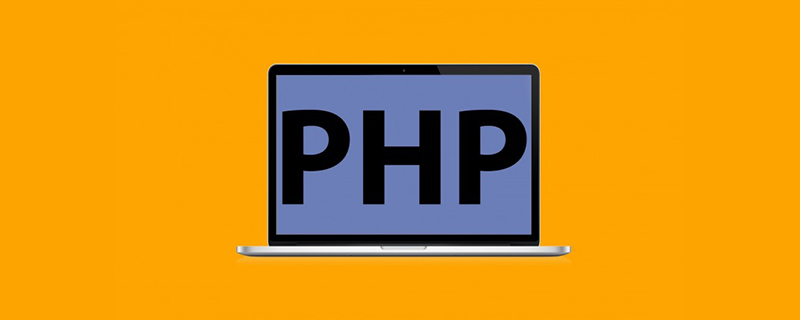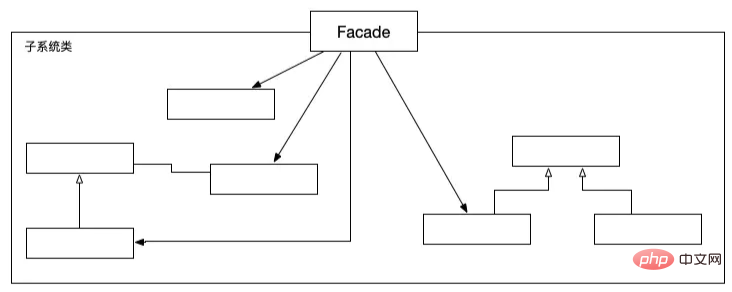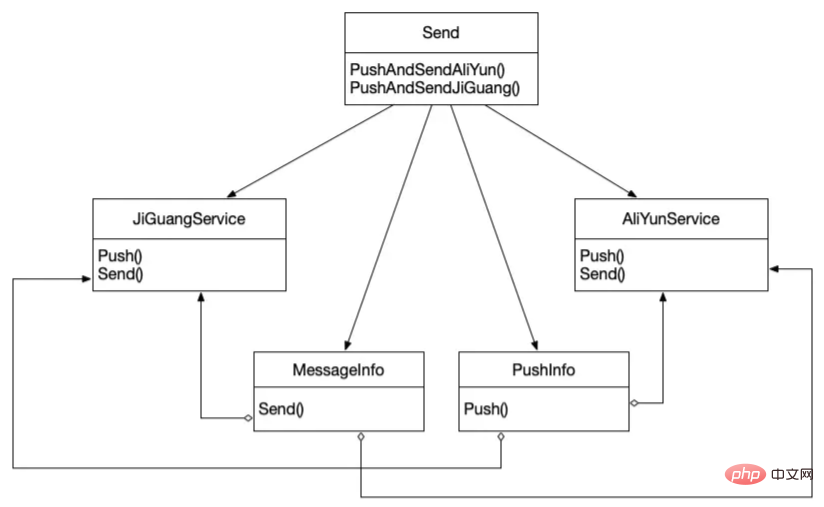Learn about the facade pattern in PHP in one article
In the previous article " A Brief Talk on the Bridge Mode in PHP" we introduced the bridge mode in PHP. The following article will take you to understand the facade mode in the PHP design pattern.

Facade mode is also called appearance mode. Whether it is the facade or appearance, it is our medium to the outside world, just like our face. Therefore, the biggest feature of this model is that it should be "good-looking". how to say? A bunch of complex object calls make me confused, especially when upgrading and maintaining old systems. Use the facade to encapsulate the function calls of the old system. From the outside, it looks the same as the new system. This is the purpose of the facade pattern!
Gof class diagram and explanation
GoF definition: Provide a consistent interface for a set of interfaces in a subsystem. The Facade pattern defines a high-level interface. This interface Makes this subsystem easier to use.
GoF class diagram

##Code implementation
class SubSystemOne
{
public function MethodOne()
{
echo '子系统方法一', PHP_EOL;
}
}
class SubSystemTwo
{
public function MethodTwo()
{
echo '子系统方法二', PHP_EOL;
}
}
class SubSystemThree
{
public function MethodThree()
{
echo '子系统方法三', PHP_EOL;
}
}
class SubSystemFour
{
public function MethodFour()
{
echo '子系统方法四', PHP_EOL;
}
}class Facade
{
private $subStytemOne;
private $subStytemTwo;
private $subStytemThree;
private $subStytemFour;
public function __construct()
{
$this->subSystemOne = new SubSystemOne();
$this->subSystemTwo = new SubSystemTwo();
$this->subSystemThree = new SubSystemThree();
$this->subSystemFour = new SubSystemFour();
}
public function MethodA()
{
$this->subSystemOne->MethodOne();
$this->subSystemTwo->MethodTwo();
}
public function MethodB()
{
$this->subSystemOne->MethodOne();
$this->subSystemTwo->MethodTwo();
$this->subSystemThree->MethodThree();
$this->subSystemFour->MethodFour();
}
}$facade = new Facade(); $facade->MethodA(); $facade->MethodB();
- The facade mode is so simple, and as long as it is a real friend who has done development in the project, he must have used this mode without knowing itWhen you The facade pattern is very suitable when you need to provide a simple interface to a complex subsystem. At the same time, if there is a large dependency between the client program and the implementation part of the abstract class, the facade pattern can also be introduced for decoupling to improve the independence and maintainability of the subsystem. In addition, when you need to build a hierarchical subsystem, the facade can serve as the entry point for each layer of subsystemI believe that anyone who has used the framework must have used the facade system in Laravel, such as: Cache:: put(). In Laravel, the facade is implemented using a magic method __callStatic(). Then let the object's methods be called directly using static methods. Isn't it amazing? Interested friends can check out the source code, which is in /Illuminate/Support/Facades/Facade.php. Key points: The three-tier structure or MVC is also a manifestation of the facade pattern. As mentioned above, the facade mode is suitable for the maintenance of hierarchical subsystems. The three-tier structure, MVC, MVP, and MVVM are essentially all for layering, and the purpose of layering is to reduce the complexity of the system.
Just selling our mobile phones is not enough. Being a high-tech home appliance company like X Mi is our ultimate goal. However, we cannot produce so many home appliances, so we decided to build a mall (Facade) to let some very high-quality merchants join our camp and put their products (SubSystem) in the mall to sell them together. Of course, these products have been carefully selected by us, and they are definitely the best among the best! !
Full code: https://github.com/zhangyue0503/designpatterns-php/blob/master/19.facade/source/facade.php
Example
This time we package the sending of text messages in the sending dimension, and package the interfaces of different text messages and push operators. When sending, we only need to use the sending class You can control the sending of text messages or push notifications using different third-party services. It’s very convenient when you think about it!SMS sending class diagram

Full source code: https://github.com/zhangyue0503/designpatterns-php /blob/master/19.facade/source/facade-push.php<?php class Send { private $aliYunService; private $jiGuangService; private $message; private $push; public function __construct() { $this->aliYunService = new AliYunService(); $this->jiGuangService = new JiGuangService(); $this->message = new MessageInfo(); $this->push = new PushInfo(); } public function PushAndSendAliYun() { $this->message->Send($this->aliYunService); $this->push->Push($this->aliYunService); } public function PushAndSendJiGuang() { $this->message->Send($this->jiGuangService); $this->push->Push($this->jiGuangService); } } class MessageInfo { public function Send($service) { $service->Send(); } } class PushInfo { public function Push($service) { $service->Push(); } } class AliYunService { public function Send() { echo '发送阿里云短信!', PHP_EOL; } public function Push() { echo '推送阿里云通知!', PHP_EOL; } } class JiGuangService { public function Send() { echo '发送极光短信!', PHP_EOL; } public function Push() { echo '推送极光通知!', PHP_EOL; } } $send = new Send(); $send->PushAndSendAliYun(); $send->PushAndSendJiGuang();Copy after loginDescription
It’s still a familiar recipe and a familiar taste . Here, you can imagine that our third-party service classes are all older interfaces, or they are already very complex interfaces. At this time, using the appearance pattern can cooperate with the new system and reduce complexity
- But it should be noted that the appearance class itself may become a source of complexity, but fortunately we can comply with a single responsibility The principle is that one appearance class can do one thing
PHP Video Tutorial"
The above is the detailed content of Learn about the facade pattern in PHP in one article. For more information, please follow other related articles on the PHP Chinese website!

Hot AI Tools

Undresser.AI Undress
AI-powered app for creating realistic nude photos

AI Clothes Remover
Online AI tool for removing clothes from photos.

Undress AI Tool
Undress images for free

Clothoff.io
AI clothes remover

Video Face Swap
Swap faces in any video effortlessly with our completely free AI face swap tool!

Hot Article

Hot Tools

Notepad++7.3.1
Easy-to-use and free code editor

SublimeText3 Chinese version
Chinese version, very easy to use

Zend Studio 13.0.1
Powerful PHP integrated development environment

Dreamweaver CS6
Visual web development tools

SublimeText3 Mac version
God-level code editing software (SublimeText3)

Hot Topics
 1389
1389
 52
52
 PHP 8.4 Installation and Upgrade guide for Ubuntu and Debian
Dec 24, 2024 pm 04:42 PM
PHP 8.4 Installation and Upgrade guide for Ubuntu and Debian
Dec 24, 2024 pm 04:42 PM
PHP 8.4 brings several new features, security improvements, and performance improvements with healthy amounts of feature deprecations and removals. This guide explains how to install PHP 8.4 or upgrade to PHP 8.4 on Ubuntu, Debian, or their derivati
 7 PHP Functions I Regret I Didn't Know Before
Nov 13, 2024 am 09:42 AM
7 PHP Functions I Regret I Didn't Know Before
Nov 13, 2024 am 09:42 AM
If you are an experienced PHP developer, you might have the feeling that you’ve been there and done that already.You have developed a significant number of applications, debugged millions of lines of code, and tweaked a bunch of scripts to achieve op
 How To Set Up Visual Studio Code (VS Code) for PHP Development
Dec 20, 2024 am 11:31 AM
How To Set Up Visual Studio Code (VS Code) for PHP Development
Dec 20, 2024 am 11:31 AM
Visual Studio Code, also known as VS Code, is a free source code editor — or integrated development environment (IDE) — available for all major operating systems. With a large collection of extensions for many programming languages, VS Code can be c
 Explain JSON Web Tokens (JWT) and their use case in PHP APIs.
Apr 05, 2025 am 12:04 AM
Explain JSON Web Tokens (JWT) and their use case in PHP APIs.
Apr 05, 2025 am 12:04 AM
JWT is an open standard based on JSON, used to securely transmit information between parties, mainly for identity authentication and information exchange. 1. JWT consists of three parts: Header, Payload and Signature. 2. The working principle of JWT includes three steps: generating JWT, verifying JWT and parsing Payload. 3. When using JWT for authentication in PHP, JWT can be generated and verified, and user role and permission information can be included in advanced usage. 4. Common errors include signature verification failure, token expiration, and payload oversized. Debugging skills include using debugging tools and logging. 5. Performance optimization and best practices include using appropriate signature algorithms, setting validity periods reasonably,
 How do you parse and process HTML/XML in PHP?
Feb 07, 2025 am 11:57 AM
How do you parse and process HTML/XML in PHP?
Feb 07, 2025 am 11:57 AM
This tutorial demonstrates how to efficiently process XML documents using PHP. XML (eXtensible Markup Language) is a versatile text-based markup language designed for both human readability and machine parsing. It's commonly used for data storage an
 PHP Program to Count Vowels in a String
Feb 07, 2025 pm 12:12 PM
PHP Program to Count Vowels in a String
Feb 07, 2025 pm 12:12 PM
A string is a sequence of characters, including letters, numbers, and symbols. This tutorial will learn how to calculate the number of vowels in a given string in PHP using different methods. The vowels in English are a, e, i, o, u, and they can be uppercase or lowercase. What is a vowel? Vowels are alphabetic characters that represent a specific pronunciation. There are five vowels in English, including uppercase and lowercase: a, e, i, o, u Example 1 Input: String = "Tutorialspoint" Output: 6 explain The vowels in the string "Tutorialspoint" are u, o, i, a, o, i. There are 6 yuan in total
 Explain late static binding in PHP (static::).
Apr 03, 2025 am 12:04 AM
Explain late static binding in PHP (static::).
Apr 03, 2025 am 12:04 AM
Static binding (static::) implements late static binding (LSB) in PHP, allowing calling classes to be referenced in static contexts rather than defining classes. 1) The parsing process is performed at runtime, 2) Look up the call class in the inheritance relationship, 3) It may bring performance overhead.
 What are PHP magic methods (__construct, __destruct, __call, __get, __set, etc.) and provide use cases?
Apr 03, 2025 am 12:03 AM
What are PHP magic methods (__construct, __destruct, __call, __get, __set, etc.) and provide use cases?
Apr 03, 2025 am 12:03 AM
What are the magic methods of PHP? PHP's magic methods include: 1.\_\_construct, used to initialize objects; 2.\_\_destruct, used to clean up resources; 3.\_\_call, handle non-existent method calls; 4.\_\_get, implement dynamic attribute access; 5.\_\_set, implement dynamic attribute settings. These methods are automatically called in certain situations, improving code flexibility and efficiency.




